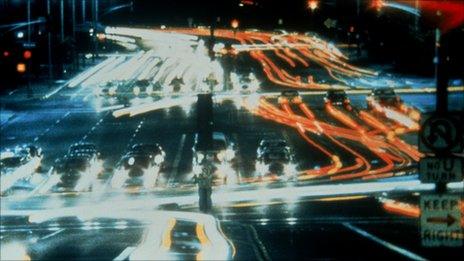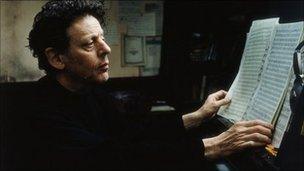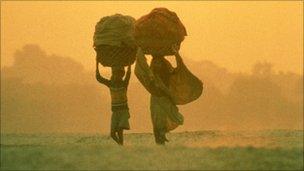Philip Glass performs film trilogy in Edinburgh
- Published

Koyaanisqatsi displays an urban society moving at a frenetic pace, overwhelmed by technology
The collaboration between composer Philip Glass and filmmaker Godfrey Reggio goes back more than 30 years.
The maverick musician whose work had been dismissed as "primitive" by the establishment of the 1960s was finally enjoying widespread acclaim when Reggio asked him to write a score for his film.
Glass, who, with his contemporaries, coined a "new language" in music would eventually do the same for film.
However, at first Glass turned Reggio down.
The composer has since written more than 30 film scores including The Truman Show and The Hours, for which he was Oscar-nominated, but he told Reggio he did not write film music.
"It was true at the time," said Glass.
"Then a friend of his called and said: 'this guy is wonderful and he is not going to leave the city until you look at the film'."
The film was Koyaanisqatsi, which means "Life out of Balance" in the Hopi language.
There were no actors, no dialogue and no linear narrative.
The film was a stream of images which sought to display an urban society moving at a frenetic pace, detached from the natural environment and overwhelmed by technology.
When Glass, now 74, first met Reggio, the filmmaker said he would show him the film twice, once with electronic music and again using Glass's music.
Glass said: "He did this and then the lights went up and he said: 'See? it works much better with your music'.
"Of course, I agreed.
"By agreeing I had stepped over the line. Then it was him and me."

Philip Glass will be performing the music live as the three films are projected
Over the next 20 years, the pair made the three films of the Qatsi Trilogy, which will be shown on consecutive nights at the Playhouse during the Edinburgh International Festival.
The Philip Glass Ensemble, featuring the composer on keyboards, will be performing the music live as the three films are projected.
The second film, Powaqqatsi, released in 1987, captured the impact of technology on native cultures around the world.
Glass's score reflects this by incorporating much of what has since become known as world music.
The third film, Naqoyqatsi, which was finished in 2001, went from the beauty of nature to a world dominated by technology, with most of the images created by computer.
Glass said: "The images are made by a machine so it could have been cold.
"So I chose to do an orchestral piece. It is basically a 90-minute cello concerto.
"The idea was to balance the machine-like images with acoustic instruments of an orchestra."
Glass said the films had proved to be an enduring success but they were not commercial.

Powaqqatsi captured the impact of technology on native cultures
He said: "The films have been very popular, the problem is they don't fit into the marketplace model of film-making, which is that you make all your money in the first three weeks.
"With Godfrey it is the opposite, you make your money in the first 10, 15 years.
"It does make it back but much slower and it is not considered a good business model.
"He has not been able to get money from the industry though everyone in the industry knows him. He's like an hero in a way."
Glass said the films only got made because of the backing of Hollywood names such as Francis Ford Coppola, George Lucas and Steven Soderbergh.
According to Glass, Hollywood producer Harvey Weinstein only put up the money for the third film because Soderbergh made it a condition of working for him.
A fourth film has been shot and Glass has been working on the music but yet again they have run into money problems.
Glass said: "The fourth is not about place any more it is about how you look at a movie.
"I call it autodidactic. It teaches you how to look at a movie.
"When you first look at it you don't even know what you are seeing.
"There will be an image of a face but there is something happening."
Glass added: "What is happening is that he has filmed it at 85 to 100 frames per second and played it back at maybe 15 so everything has been slowed down to the point where you can see the tremor of a face.
"The way we look at things has to do with the timeframe in which we look at them.
"After you have seen the movie everything looks different."